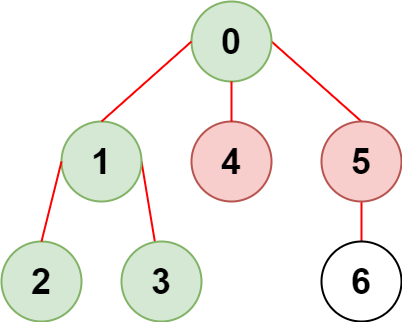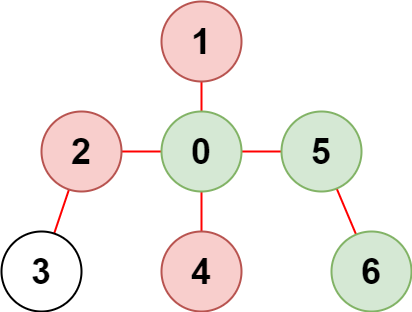Class Solution
java.lang.Object
g2301_2400.s2368_reachable_nodes_with_restrictions.Solution
2368 - Reachable Nodes With Restrictions\.
Medium
There is an undirected tree with `n` nodes labeled from `0` to `n - 1` and `n - 1` edges.
You are given a 2D integer array `edges` of length `n - 1` where
edges[i] = [ai, bi] indicates that there is an edge between nodes ai and bi in the tree. You are also given an integer array `restricted` which represents **restricted** nodes.
Return _the **maximum** number of nodes you can reach from node_ `0` _without visiting a restricted node._
Note that node `0` will **not** be a restricted node.
**Example 1:**

**Input:** n = 7, edges = \[\[0,1],[1,2],[3,1],[4,0],[0,5],[5,6]], restricted = [4,5]
**Output:** 4
**Explanation:** The diagram above shows the tree. We have that [0,1,2,3] are the only nodes that can be reached from node 0 without visiting a restricted node.
**Example 2:**

**Input:** n = 7, edges = \[\[0,1],[0,2],[0,5],[0,4],[3,2],[6,5]], restricted = [4,2,1]
**Output:** 3
**Explanation:** The diagram above shows the tree. We have that [0,5,6] are the only nodes that can be reached from node 0 without visiting a restricted node.
**Constraints:**
* 2 <= n <= 105
* `edges.length == n - 1`
* `edges[i].length == 2`
* 0 <= ai, bi < n
* ai != bi
* `edges` represents a valid tree.
* `1 <= restricted.length < n`
* `1 <= restricted[i] < n`
* All the values of `restricted` are **unique**.-
Constructor Summary
Constructors -
Method Summary
-
Constructor Details
-
Solution
public Solution()
-
-
Method Details
-
reachableNodes
public int reachableNodes(int n, int[][] edges, int[] restricted)
-